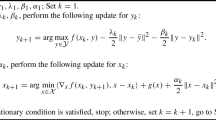Abstract
In finite scattering propagation environment, when the number of scatterers is very small compared to the number of base station antennas and users in the cell and if the same scatterers are shared by all users, then the correlation among the users increases. Hence, the high-dimensional multi-user MIMO system is likely to have low-rank channel. To estimate the channel matrix, weighted nuclear norm minimization method is proposed in this paper. Iterative weighted singular value thresholding algorithm is used to solve the optimization problem. To recover the low-rank channel, a partial random Fourier matrix (PRFM) satisfying the restricted isometric property is adapted as the training matrix. The PRFM forces the iterative algorithm to converge in one iteration which reduces the huge computational complexity of the proposed channel estimation method. The mean square error and achievable sum rate are the criteria used to measure the performance of the proposed method. The results show that the proposed method outperforms the least square estimation method and the nuclear norm minimization method for various finite scatterers in different SNR levels.










Similar content being viewed by others
References
R.G. Baraniuk, Compressive sensing. IEEE Signal Process. Mag. 24(4), 1–10 (2007)
C.R. Berger, Z. Wang, J. Huang, S. Zhou, Application of compressive sensing to sparse channel estimation. IEEE Commun. Mag. 48(11), 164–174 (2010)
E. Candes, C.A. Sing-Long, J.D. Trzasko, Unbiased risk estimates for singular value thresholding and spectral estimators. IEEE Trans. Signal Process. 61(19), 4643–4657 (2013)
E.J. Candes, T. Tao, Near-optimal signal recovery from random projections: universal encoding strategies? IEEE Trans. Inf. Theory 52(12), 5406–5425 (2006)
T.T. Do, N.H.N. Lu Gan, T.D. Tran, Fast and efficient compressive sensing using structurally random matrices. IEEE Trans. Signal Process. 60(1), 139–154 (2012)
S. Gu, Z. Lei, Z. Wangmeng, F. Xiangchu, Weighted nuclear norm minimization with application to image denoising, in Proceedings of the IEEE Conference on Computer Vision and Pattern Recognition (2014), pp. 2862–2869
J. Hoydis, T.B. Stephan, D. Merouane, Massive MIMO in the UL/DL of cellular networks: How many antennas do we need? IEEE J. Sel. Areas Commun. 31(2), 160–171 (2013)
P. Jain, R. Meka, I.S. Dhillon, Guaranteed rank minimization via singular value projection, in Advances in Neural Information Processing Systems (2010), pp. 937–945
J. Josse, S. Sardy, Adaptive shrinkage of singular values. Stat. Comput. 26(3), 715–724 (2015)
Y.-F. Li, Y.-J. Zhang, Z.-H. Huang, A reweighted nuclear norm minimization algorithm for low rank matrix recovery. J. Comput. Appl. Math. 263, 338–350 (2014)
L. Lu, G.Y. Li, A.L. Swindlehurst, A. Ashikhmin, R. Zhang, An overview of massive MIMO: benefits and challenges. IEEE J. Sel. Top. Signal Process. 8(5), 742–758 (2014)
T.L. Marzetta, How much training is required for multiuser MIMO? in Signals, Systems and Computers Conference (ACSSC) (IEEE, 2006), pp. 359–363
T.L. Marzetta, Noncooperative cellular wireless with unlimited numbers of base station antennas. IEEE Trans. Wirel. Commun. 9(11), 3590–3600 (2010)
H.Q. Ngo, E.G. Larsson, T.L. Marzetta, Energy and spectral efficiency of very large multiuser MIMO systems. IEEE Trans. Commun. 61(4), 1436–1449 (2013)
H.Q. Ngo, E.G. Larsson, EVD-based channel estimations for multicell multiuser MIMO with very large antenna arrays, in IEEE International Conference on Acoustics, Speech and Signal Processing (ICASSP) (2012), pp. 3249–3252
S.L.H. Nguyen, A. Ghrayeb, Precoding for multicell massive MIMO systems with compressive rank-q channel approximation, in IEEE 24th International Symposium on Personal Indoor and Mobile Radio Communications (PIMRC) (2013), pp. 1227–1232
S.L.H. Nguyen, A. Ghrayeb, Compressive sensing-based channel estimation for massive multiuser MIMO systems, in Wireless Communications and Networking Conference (WCNC) (IEEE, 2013), pp. 2890–2895
T. Nikazad, The Use of Landweber Algorithm in Image Reconstruction (2007)
B. Recht, M. Fazel, P.A. Parrilo, Guaranteed minimum-rank solutions of linear matrix equations via nuclear norm minimization. SIAM Rev. 52(3), 471–501 (2010)
M. Rudelson, R. Vershynin, Non-asymptotic Theory of Random Matrices: Extreme Singular Values. arXiv preprint arXiv:1003.2990 (2010)
N. Shariati, E. Bjornson, M. Bengtsson, M. Debbah, Low complexity polynomial channel estimation in large scale MIMO with arbitrary statistics. IEEE J. Sel. Top. Signal Process. 8(5), 815–830 (2014)
R. Vershynin, Spectral norm of products of random and deterministic matrices. Probab. Theory Rel. Fields 150(3–4), 471–509 (2011)
K. Zheng, S. Ou, X. Yin, Massive MIMO channel models: a survey. Int. J. Antennas Propag. 2014, 848071 (2014). doi:10.1155/2014/848071
Author information
Authors and Affiliations
Corresponding author
Appendix: Convergence Analysis
Appendix: Convergence Analysis
The convergence of the proposed iterative algorithm is analysed by assuming the regularizer factor \(\lambda =0\). Then the term \(||\mathbf y -\varvec{\varPsi } \mathbf h ||_2^2\) in (6) can be solved iteratively using Landweber iterative method in matrix form as
which can be rewritten as
Since \(\mathbf H _0\) is initialized to be all zero matrix, obtain using the above recursion \(\mathbf H _1\) to be
and
Rearranging the equation \(\mathbf H _2\) in terms of \(\mathbf H _1\)
Similarly, we obtain \(\mathbf H _3\) as
In general, the iterative equation is written as
Using the expression for the sum of a geometric series, we obtain
For a partial DFT matrix \(\varvec{\varPhi }\varvec{\varPhi }^H=\mathbf I \) and if we assume \(\beta \) =1 then (9) converges to \(\mathbf Y \varvec{\varPhi }^H\), i.e. in one iteration.
Rights and permissions
About this article
Cite this article
Vanidevi, M., Selvaganesan, N. Channel Estimation for Finite Scatterers Massive Multi-User MIMO System. Circuits Syst Signal Process 36, 3761–3777 (2017). https://doi.org/10.1007/s00034-016-0489-y
Received:
Revised:
Accepted:
Published:
Issue Date:
DOI: https://doi.org/10.1007/s00034-016-0489-y




